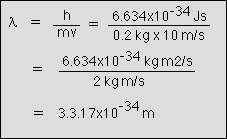|
Traditional (classical) physics had assumed that particles
were particles and waves were waves and thats that. However,
de Broglie suggested that particles could sometimes behave as
waves and waves could sometimes bahave as particles - the wave/particle
duality of nature. He suggested a simple equation that would
relate the two: Particles have momentum (p), waves have wavelengths
(l) and the two are related by the
equation
l=h/p
h=Planck's constant
= 6.634x10-34 Js
p=(mass)x(velocity)
This wave/particle duality of nature turned out to be a key
to the new atomic theory. Here is an examples of using the de
Broglie equation:
Question: A ball of mass 0.2 kg is thrown with a velocity
of 10 m/s what is its wavelength?
Answer:

This means that the wavelength of the
ball is miniscule compared to the size of the ball.
|

